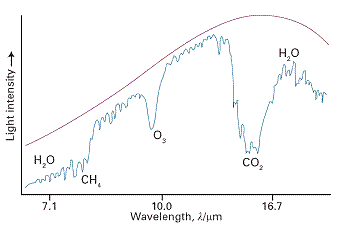Chapter 1. Impact 9.2
Impact …ON ENVIRONMENTAL SCIENCE: I9.2 Climate change*
Solar energy strikes the top of the Earth’s atmosphere at a rate of 343 W m–2. About 30 per cent of this energy is reflected back into space by the Earth or the atmosphere. The Earth–atmosphere system absorbs the remaining energy and re-emits it into space as black-body radiation, with most of the intensity being carried by infrared radiation in the range 200–2500 cm–1 (4–50 μm). The Earth’s average temperature is maintained by an energy balance between solar radiation absorbed by the Earth and black-body radiation emitted by the Earth.
The trapping of infrared radiation by certain gases in the atmosphere is known as the greenhouse effect, so called because it warms the Earth as if the planet were enclosed in a huge greenhouse. The result is that the natural greenhouse effect raises the average surface temperature well above the freezing point of water and creates an environment in which life is possible. The major constituents to the Earth’s atmosphere, O2 and N2, do not contribute to the greenhouse effect because homonuclear diatomic molecules cannot absorb infrared radiation. However, the minor atmospheric gases, water vapour and CO2, do absorb infrared radiation and hence are responsible for the greenhouse effect (Fig. 1). Water vapour absorbs strongly in the ranges 1300–1900 cm–1 (5.3–7.7 μm) and 3550–3900 cm–1 (2.6–2.8 μm), whereas CO2 shows strong absorption in the ranges 500–725 cm–1 (14–20 μm) and 2250–2400 cm–1 (4.2–4.4 μm).

Fig. 1. The intensity of infrared radiation that would be lost from Earth in the absence of greenhouse gases is shown by the brown line. The blue line is the intensity of the radiation actually emitted. The maximum wavelength of radiation absorbed by each greenhouse gas is indicated.
Increases in the levels of greenhouse gases, which also include methane, dinitrogen oxide, ozone, and certain chlorofluorocarbons, as a result of human activity have the potential to enhance the natural greenhouse effect, leading to significant warming of the planet. This problem is referred to as global warming, and more generally as climate change, which we now explore in some detail.
The concentration of water vapour in the atmosphere has remained steady over time, but concentrations of some other greenhouse gases are rising. From about the year 1000 until about 1750, the CO2 concentration remained fairly stable, but, since then, it has increased by 28 per cent. The concentration of methane, CH4, has more than doubled during this time and is now at its highest level for 160 000 years (160 ka; 1 a is the SI unit denoting 1 year). Studies of air pockets in ice cores taken from Antarctica show that increases in the concentration of both atmospheric CO2 and CH4 over the past 160 ka correlate well with increases in the global surface temperature.
Human activities are primarily responsible for the rising concentrations of atmospheric CO2 and CH4. Most of the atmospheric CO2 comes from the burning of hydrocarbon fuels, which began on a large scale with the Industrial Revolution in the middle of the nineteenth century. The additional methane comes mainly from the petroleum industry and from agriculture.
The temperature of the surface of the Earth has increased by about 0.8 K since the middle of the nineteenth century (Fig. 2). In 2013 the Intergovernmental Panel on Climate Change (IPCC) estimated that our continued reliance on hydrocarbon fuels, coupled to current trends in population growth, could result in an additional increase of 1.5–3 K in the temperature of the Earth by 2100, relative to the surface temperature in 2000. Furthermore, the rate of temperature change is likely to be greater than at any time in the last 10 ka. To place a temperature rise of 3 K in perspective, it is useful to consider that the average temperature of the Earth during the last ice age was only 6 K colder than at present. Just as cooling the planet (for example, during an ice age) can lead to detrimental effects on ecosystems, so too can a dramatic warming of the globe. One example of a significant change in the environment caused by a temperature increase of 3 K is a rise in sea level by about 0.5 m, which is sufficient to alter weather patterns and submerge coastal ecosystems.

Fig. 2. The average change in surface temperature of the Earth from 1850 to 2010.
Computer projections for the next 200 years predict further increases in atmospheric CO2 levels and suggest that, to maintain CO2 at its current concentration, we would have to reduce hydrocarbon fuel consumption immediately by about 50 per cent. Clearly, in order to reverse global warming trends, we need to develop alternatives to fossil fuels, such as hydrogen (which can be used in fuel cells) and solar energy technologies.
*This section is based on a similar contribution initially prepared by Loretta Jones and appearing in Chemical principles, Peter Atkins, Loretta Jones, and Leroy Laverman, W.H. Freeman and Co., New York (2013).